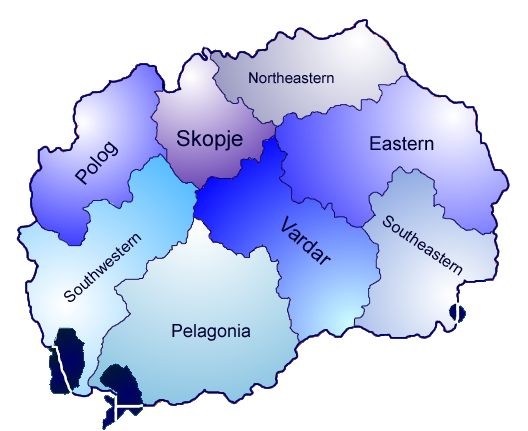Macedonia
|
|

Basic Info
Macedonia, officially the Republic of Macedonia, is a country located in the central Balkan peninsula in Southeast Europe. It is one of the successor states of the former Yugoslavia, from which it declared independence in 1991. It became a member of the United Nations in 1993 but, as a result of a dispute with Greece over its name, it was admitted under the provisional reference of the former Yugoslav Republic of Macedonia, sometimes abbreviated as FYROM.

Geography
Macedonia has a total area of 25,713 km2 (9,928 sq mi). It lies between latitudes 40° and 43° N, and mostly between longitudes 20° and 23° E (a small area lies east of 23°). Macedonia has some 748 km (465 mi) of boundaries, shared with Serbia (62 km or 39 mi) to the North, Kosovo (159 km or 99 mi) to the northwest, Bulgaria (148 km or 92 mi) to the east, Greece (228 km or 142 mi) to the south, and Albania (151 km or 94 mi) to the west. It is a transit way for shipment of goods from Greece, through the Balkans, towards Eastern, Western and Central Europe and through Bulgaria to the East. It is part of a larger region also known as Macedonia, which also includes a region of northern Greece known by the same name; and the Blagoevgrad province in southwestern Bulgaria.
Climate
Macedonia has a transitional climate from Mediterranean to continental. The summers are hot and dry and the winters are moderately cold. Average annual precipitation varies from 1,700 mm (66.9 in) in the western mountainous area to 500 mm (19.7 in) in the eastern area. There are three main climatic zones in the country: temperate Mediterranean, mountainous and mildly Continental.
Along the valleys of the Vardar and Strumica rivers, in the regions of Gevgelija, Valandovo, Dojran, Strumica and Radoviš the climate is temperate Mediterranean. The warmest regions are Demir Kapija and Gevgelija, where the temperature in July and August frequently exceeds 40 °C (104 °F). The mountainous climate is present in the mountainous regions of the country and it is characterised by long and snowy winters and short and cold summers. The spring is colder than the fall. The majority of Macedonia has a moderate continental climate with warm and dry summers and relatively cold and wet winters. There are 30 main and regular weather stations in the country.
Religion
Orthodox Christianity is the majority faith of the Republic of Macedonia making up 64.7% of the population, the vast majority of which belong to the Macedonian Orthodox Church. Various other Christian denominations account for 0.37% of the population. muslims comprise 33.3% of the population; Macedonia has the fifth-highest proportion of muslims in Europe, after those of Turkey (96%), Kosovo (90%), Albania (56.7%), and Bosnia-Herzegovina (45%). Most muslims are Albanians, Turks, or Roma, although some are Macedonian muslims. The remaining 1.63% is recorded as "unspecified" in the 2002 national census.
Administrative divisions
Macedonia's statistical regions exist solely for legal and statistical purposes. The regions are:

Skopje
Pelagonia
Polog
Eastern
Southeastern
Northeastern
Southwestern
Vardar
Site Search
News
Random Articals
Weather
Join Our Newsletter
Send This Page to Friend
To Email this page to a friend
1. Use Your Default Email Client
2. Use Our Recommend Page
Online Contact
nouahsark
1438084734
+ 86 158 00 323 707
+ 86 158 00 323 707
nouahsark@hotmail.com

If you like this article please feel free to share it to your favorite site listed below: